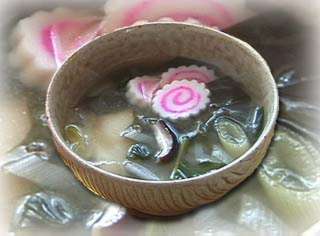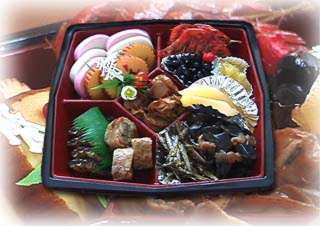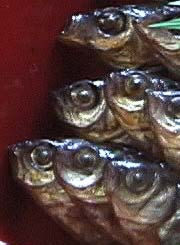
| Intro | Speech contest | Pizza delivery | Osechi foods | Gallery show | Marble house | Kamakura | Bonenkai | Bonenkai 2 | Emperor | Sapporo | Walking | Hanami | Visitors | Skiing | 7 Lucky gods | Visitor's survival guide | Kasuga |
foods of the new year
31 December 2000

My refrigerator is full of lucky foods awaiting tomorrow's new year feast.
During the last days of the year, wives and mothers around the nation busily prepare osechi ryori, elegant new year foods packed in jyubako, multi-layered lacquer boxes.
Although I signed up to take a workshop to learn to make my own osechi just like okaasan ("mom" in Japanese), an unexpected trip to Chicago had me out of the country on the class date. So I took the lazy way out and bought my osechi ryori ready-made at the grocery store yesterday. It came in a rather inelegant, one-layer plastic box.
Real jyubako, three to five layers of shallow boxes in black or vermilion lacquer decorated with gilt patterns ranging from natural elements to modern abstracts, are passed down from generation to generation much like the fancy china services are passed along in our Western families. If you want to buy a new set of jyubako you can expect to spend up to $2000. Needless to say, I'm content with my disposable plastic box.
The osechi foods in the jyubako are as beautiful as the boxes themselves and as steeped in tradition and symbolism as they are in sauces.
Seichi were banquets held in the Imperial Japanese court over 1,000 years ago. They celebrated the transition from one season to another. Though the passage of osechi from royal banquet to home cooking is lost in the ages, it's possible that people began to offer some of these imperial treats to the toshigama, year-god, who is said to visit homes on the first day of the new year.
From royal banquet and sacred offering, osechi ryori has transformed into a way for housewives to enjoy a respite from cooking during the new year holiday. Osechi is prepared ahead of time, and all the dishes will keep for several days. Only rice and soup need to be prepared at each mealtime.
 For soup, ozoni is a new year's tradition. In Tokyo, the soup is made with a clear fish stock and vegetables. The star of the soup is a mochi cake. Mochi is a sticky rice that's been pounded into a soft, chewy dough. When you eat ozoni, you're supposed to take one end of your mochi in your teeth and the other end in your chopsticks and stretch it like taffy. They say the longer the stretch, the longer you'll live. Mochi is extremely chewy stuff, and every year a few elderly mochi-eaters choke to death on it. Quite ironic, but the newspapers warn people not to let their grandparents eat mochi alone.
For soup, ozoni is a new year's tradition. In Tokyo, the soup is made with a clear fish stock and vegetables. The star of the soup is a mochi cake. Mochi is a sticky rice that's been pounded into a soft, chewy dough. When you eat ozoni, you're supposed to take one end of your mochi in your teeth and the other end in your chopsticks and stretch it like taffy. They say the longer the stretch, the longer you'll live. Mochi is extremely chewy stuff, and every year a few elderly mochi-eaters choke to death on it. Quite ironic, but the newspapers warn people not to let their grandparents eat mochi alone.
Back to the jyubako, each layer of the box contains a different type of food: simmered vegetables go in the lowest box; vinegared vegetable and fish salads are a layer above. The top box is for the metaphorical foods.
My osechi is only the metaphorical foods. What do I have?
Prawns stand for longevity. I have no idea why, but you can be sure I'll eat a bunch of these. I wonder which has more influence on the length of my life, the osechi prawns or the mochi in the ozoni? I'll make sure I stretch my mochi well, but I bought some extra prawns just to be on the safe side.
Kuromame are shiny black beans. Beans are pretty universal as far as foods go--these are about the size of lima beans and are cooked whole in a sweet sauce. They bring health in the new year.
 Kurikinton stands for wealth. It's another sweet dish--a mash of sweet potatoes and chestnuts cooked in syrup. The gold color evokes the precious metal and the "kin" in its name means "gold" in Japanese.
Kurikinton stands for wealth. It's another sweet dish--a mash of sweet potatoes and chestnuts cooked in syrup. The gold color evokes the precious metal and the "kin" in its name means "gold" in Japanese.
Kamaboku symbolizes the sunrise. It's a circular slice of fish paste colored white with a pink center. Because I like the taste and smooth texture of fish paste, like gelatinous, fish-flavored liverwurst, I bought an extra one. It's whimsically pretty; pentagonal with the kanji for "snake year" in red on a yellow and green background.
Kobumaki is boiled herring wrapped with seaweed. Kombu (also called kobu) is the seaweed used to make dashi broth for ozoni and miso soups. It's thick, chewy and dark green. It tastes slightly like seawater. Because of a play on the word yorokobu,"to become happy," kobumaki stands for happiness.
Datemaki is a fluffy sweetened egg omelet rolled up in a bamboo mat which makes indentations in the roll. Each slice looks a little bit like a brain and that's appropriate because datemaki is for learning and knowledge. I bought us an extra one of these because you can never have too much knowledge.
Tatakigobo is burdock root with sesame dressing. Burdock is a weed in America, but food in Japan. It is a taproot with an earthy flavor and a tough texture. Despite that, I like burdock very much. In osechi, burdock represents energy because it is rooted so firmly in the earth. Is that because it takes a lot of energy to harvest or because it's tapping into a geothermal energy? I don't know.
There are a few things in my osechi box that I'm not so sure I want to eat. Call me squeamish but would you eat these?

Kazunoko is herring roe. It's a pale yellow in color and slightly translucent. Looking at it close up, I can see the individual eggs, but looking at it from a distance, it looks a little bit like a section of a very large grapefruit. Since I don't like eating eggs of any sort and the symbolism for this one (many descendants) isn't really on my wish list for 2001, I may just stop at a small nibble.
Tazukuri is a pile of slim, silver fish, dried and seasoned with soy. This is popular bar food, sort of like the packets of Blind Robins available at every divey bar in Pittsburgh. Tazukuri taste pretty good but the bones are crunchy and the little eyes looking at me are disturbing. Tazukuri ensures a good harvest but I think I'll risk next year's basil without the auspicious good wishes of these little fishes.
Terigomame are whole, finger-sized baby sardines simmered in sugar and soy sauce. I don't know what meaning they convey, but they are staring at me from their corner of the box. Some of them have their mouths open, as if screaming. The soy and sugar sauce make them a really lovely burnished gold color, but I'm just not sure I can bring myself to eat them.
Maybe toshigama, the year-god, will like the roe and the whole fishes. That's all I plan to share with him. Tod and I will eat the rest ourselves and supplement our new years meals with roast beef sandwiches and BLTs.
Yoi otoshi wo! (Good new year!)